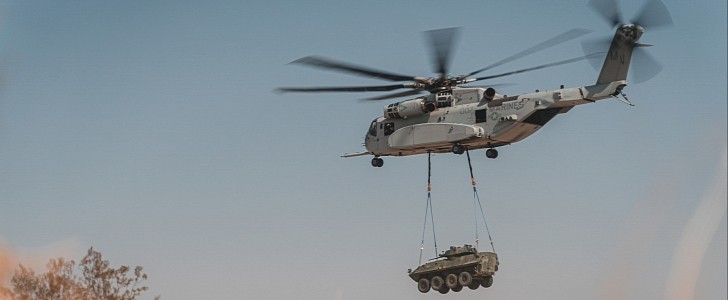The U.S. Marine Corps declared the CH-53K King Stallion heavy-lift helicopter operational. The aircraft will allow the Marines and allied forces to move both troops and equipment more rapidly and effectively from ship to shore in various mission scenarios.
Designed and built by Sikorsky, a Lockheed Martin wholly-owned subsidiary, the U.S. Marine Corps' CH-53K is a replacement for the CH-53E. The helicopter can carry nearly 27,000 lbs (12,247 kg) in challenging environments, which is almost three times the lift capacity of the CH-53E.
It was also developed to operate at lower costs. Compared to its predecessor, the King Stallion's T408-GE-400 turboshaft engines deliver 57 percent more horsepower with 63 percent fewer components. This results in the increased potential to transport internal and exterior cargo loads.
The helicopter's design is also maintenance-friendly since it has an integrated vehicle health management system that automatically checks and regulates the operation of avionics systems, crucial dynamic components, and engine performance.
The CH-53K began its Initial Operational Test and Evaluation last year, and recently, the U.S. Marines have declared Initial Operational Capability (IOC) for the heavy-lifter.
"This declaration is a vote of confidence from Marine Corps leadership and demonstrates the critical role of the CH-53K, giving forces more range and agility to conduct expeditionary heavy-lift assault transport of armored vehicles, equipment, and personnel. This capability is critical in the Indo-Pacific region and around the globe in support of the joint force and allies," said Sikorsky President Paul Lemmo.
In addition to achieving IOC requirements, the aircraft has completed over 3,000 flight hours in a variety of settings, including extreme temperatures. The helicopters have also been used in exercises that include air-to-air refueling with a 27,000-lb (12,247-kg) external load. Furthermore, they have performed over 350 landings and completed live fire testing and evaluation as well.
The first deployment of the CH-53K is expected to take place in 2024. The Marine Corps' procurement objective is 200 helicopters.
It was also developed to operate at lower costs. Compared to its predecessor, the King Stallion's T408-GE-400 turboshaft engines deliver 57 percent more horsepower with 63 percent fewer components. This results in the increased potential to transport internal and exterior cargo loads.
The helicopter's design is also maintenance-friendly since it has an integrated vehicle health management system that automatically checks and regulates the operation of avionics systems, crucial dynamic components, and engine performance.
The CH-53K began its Initial Operational Test and Evaluation last year, and recently, the U.S. Marines have declared Initial Operational Capability (IOC) for the heavy-lifter.
"This declaration is a vote of confidence from Marine Corps leadership and demonstrates the critical role of the CH-53K, giving forces more range and agility to conduct expeditionary heavy-lift assault transport of armored vehicles, equipment, and personnel. This capability is critical in the Indo-Pacific region and around the globe in support of the joint force and allies," said Sikorsky President Paul Lemmo.
In addition to achieving IOC requirements, the aircraft has completed over 3,000 flight hours in a variety of settings, including extreme temperatures. The helicopters have also been used in exercises that include air-to-air refueling with a 27,000-lb (12,247-kg) external load. Furthermore, they have performed over 350 landings and completed live fire testing and evaluation as well.
The first deployment of the CH-53K is expected to take place in 2024. The Marine Corps' procurement objective is 200 helicopters.
The @USMC declared Initial Operational Capability (IOC) for the CH-53K heavy lift helicopter, validating the platform’s operational readiness to forward deploy Marines and equipment across the globe. #OnlyTheKCan pic.twitter.com/glGYU6xima
— Sikorsky (@Sikorsky) April 25, 2022






